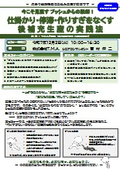Out-of-stock and excess inventory are caused by forecasted production. Now is the time to rethink and move away from push!
【Key Points of This Seminar】 - What is "push-type"? The true nature of waste commonly found on-site - Basic principles of pull production and steps for on-site implementation - The concept of "downstream pull" to reduce work-in-progress and inventory - Case studies of companies that have made improvements - Specific methods to establish a small start 【Target Audience: Improvement Leaders and Managers】 - Those who feel there is excessive production, stagnation, and unnecessary movements on-site - Those struggling with the gap between production planning and actual work - Those looking for ways to sustain improvement activities - Those who want to know practical implementation methods of TPS (Toyota Production System) ~ Visualizing waste to achieve "just enough, just in time" ~ "Is your site being 'pushed'?" On-site issues often include "producing but not using" and "work-in-progress overflowing and halting flow." Many of these problems may stem from push-type production, which is based on "producing just in case" rather than "producing because it is needed." A chain moves easily when "pulled," but what happens when it is "pushed"? ── This is precisely the difference between push and pull. We will teach you the mechanism of production that "does not overproduce and does not stagnate" through the concept of "pull production."
Inquire About This Product
basic information
**Lecture Content** 1. For Corporate Survival 1) The Mission of the Company 2) The Selling Price is Determined by the Customer 3) Two Methods of Arithmetic Calculation 2. Two Activities Promoted by the Toyota Group 1) Reduction of Lead Time 2) Pursuit of One-Man Operations 3. What is Pull Production (Downstream Process Pull)? 1) Difference Between Pull and Push 2) What is Pull Production? 3) The Era Where "If You Make It, It Will Sell" is a Distant Past 4. JIT (Just In Time) is Customer-Oriented Pull Production 1) Just In Time 2) Tools for Pull Production (Kanban) 3) Advantages and Disadvantages of Pull Production 5. What is Push Production (Upstream Process Push)? 1) In the Era Where "If You Make It, It Will Sell," It Was Good to Produce More 2) In Such Times, Push Production is Acceptable 3) Advantages and Disadvantages of Push Production 6. Three Conditions for Building JIT 1) Streamlining the Process 2) Determining Takt Time 3) Downstream Process Pull - Creation of Equipment Operation Planning Table (Exercise) *Note: The content of the lecture may change slightly.*
Price information
Participation fee: 37,950 yen per person (including tax)
Price range
P2
Delivery Time
Applications/Examples of results
Date and Time August 6, 2025 (Wednesday) Instructor Shinji Yoshimura, Senior Consultant, T.M.A. Co., Ltd. *For more details, please download the PDF or contact us. - To participate in the seminar, you will need a computer with internet access, a microphone, speakers, and a camera. (This is an online seminar using ZOOM meetings.) - After your application is received, a simple connection test will be conducted, so even first-time participants can feel at ease.
catalog(1)
Download All CatalogsNews about this product(1)
Company information
Our company was established 30 years ago, inspired by the teachings of Mr. Taiichi Ohno, the father of the Toyota Production System and former Vice President of Toyota Motor Corporation. The previous president, Shigehiko Sugawara, learned the methods of on-site improvement based on the Toyota Production System, as well as the supporting PM. After Mr. Ohno's passing, we established T.M.A. Co., Ltd. in 1992 to carry on his legacy. Manufacturing is about developing people. It involves creating sellable products based on the fundamental concepts of the Toyota Production System: "Just-In-Time" and "Jidoka." This means producing only what can be sold, when it can be sold, with a waste-free combination of people, machines, and materials, all within the shortest lead time. To achieve this, it is essential for the manufacturing, sales, and development departments to work together as one cohesive unit. We aim to realize manufacturing and human development that challenges together, leverages for the future, and creates the next stage. As a result, people grow, and a resilient corporate culture emerges. Our company strongly supports these initiatives. We operate six business areas: 1. On-site improvement consulting and seminar instructor dispatch 2. Online seminars and group seminars 3. T-Mate system 4. Book publishing and sales 5. Correspondence education 6. Video distribution




